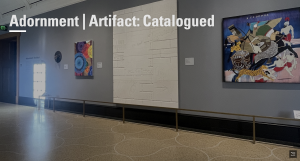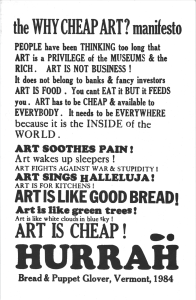11 Hesse
WIld goose chase:
tracking down (filling in the) information for educational institutions
by Madison Hesse
I. Project Introduction
This project aims to do the work of addressing the theoretical problems associated with museums’ contribution to erasure by restricting access to information, and actively works to fill one content gap produced by this erasure. Below, I center a case study: the Adornment | Artifact exhibition at the Getty Villa, and investigate how the museum’s vested interest in maintaining a public perception of woke-ness can actively do harm to artists and communities. As an exhibit which claims a resistance to the decontextualization of cultural objects, the absence of almost any information on the pieces and artists involved, in addition to the bold placement of the exhibition near offensive or controversial ‘artifacts,’ calls into question the Getty Villa’s intentions behind displaying the pieces.
To begin, I would like to make it clear that I believe the folks at Transformative Arts who curated the Adornment | Artifact collection and are showcasing the artworks across Southern California are doing incredibly meaningful work. Their commitment to building sustainable community relationships, providing equitable access to radical narratives, and celebrating artists who subversively engage with power is inspiring, and serves as a source of hope for how the art world can operate to primarily serve communities. In an attempt to not speak over the curators of Adornment |Artifact, I would like to share the “Story” page on their website as an introduction to their work, as opposed to summarizing it for myself and ultimately only reducing.
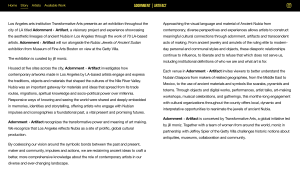
image from: https://www.adornmentartifact.org/
This line stands out to me specifically: “From ancient jewelry and amulets of the ruling elite to modern-day personal and communal styles and objects, [these] diasporic relationships continue to influence, to liberate and to refuse that which does not serve us, including institutional definitions of who we are and what art is for.” Adornment | Artifact, at its core, incorporates the human urges to make, to collect, and to connect with the past into a transformative initiative unlike anything I personally have ever seen.
Their exhibit in the Getty Villa, which includes artworks by Melvin Edwards, June Edmonds, Lauren Halsey, and Umar Rashid, specifically interests me for a few reasons which I have laid out in the following modules. First, I have included an annotated map of the second floor balcony of the Getty Villa, specifically marking several art pieces or installations which, only a few steps from Adornment | Artifact, suggest that the Villa’s commitment to the foundational ideals of Transformative Arts’ initiative might be lackluster.
II. Annotated Map of the Getty / Introduction to Theoretical Issues
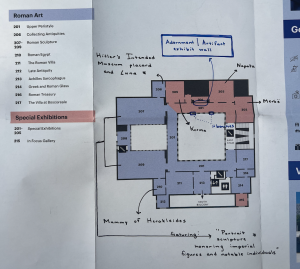
With this physical map that I picked up when I last visited the Getty Villa, I wanted to demonstrate how the physical space/layout of the Villa contributes to the conflicting feeling I personally got from the exhibit immediately after seeing it for the first time. For context, Adornment | Artifact is nestled right next to the room at the Getty Villa which features an art piece from Hitler’s Intended Museum (Luna), is right down the hall from a mummy with real human remains (Mummy of Herakleides), and can be seen from galleries which almost exclusively feature portrait sculptures honoring imperial figures (Gallery 207, Gallery 209). Given that one of the pieces in Adornment | Artifact contains the names of victims of police brutality in America’s recent past, and given that the Classical tradition has historically been a tool for legitimizing ‘the West’ and its colonial legacy, the physical positioning of these objects is worth consideration.
Additionally, although difficult to tell from the map, I find it worth nothing that Adornment | Artifact is not located in a gallery of its own. Though only four pieces, there are rooms in the Getty Villa devoted to fewer pieces — rooms with hardly enough space for four people to stand comfortably and rooms with their own engraved placards to house a very small selection of artifacts. Adornment | Artifact is located on one wall of a hallway, at eye level with most attendees yet easily passed over due to its placement. A single wooden bench, large enough for potentially two viewers, serves as the only encouragement provided by the museum to sit, to witness, and to contemplate the pieces.
III. Getty Website Walk-through
Next, I wanted to record a video in which I mimic the dilemma I encountered after I had seen the Adornment | Artifact exhibit for the first time and had returned home trying to find information, images, reviews, etc. for the exhibit anywhere online:
Video Transcript (the computer generated transcript of my audio recording is not perfect by any stretch of the imagination, but hopefully it makes the video more accessible for those who need it)
*The second video in this series is on its way – I am waiting on correspondence from one of my sources before I finalize it!*
IV. Gallery Images Catalogued
Click below! The image is an embedded link to a Microsoft Sway presentation I mad in an attempt to create a catalog of the four art pieces in the Getty Villa’s Adornment | Artifact collection with clear (yet very amateur) photographs taken at multiple angles. This presentation does some of the work that the Getty Villa has not yet done to properly give credit to the artists featured in the museum, and hopefully will help put the physical hallway gallery space discussed on the 2-Dimensional map into perspective.
V. Artist Biographies
To track down information on the Getty Villa’s exhibition and on the four artists, I attempted to reach out to a contact of Professor Valentine’s who works at the Getty Research Institute, jill moniz who curated Adornment | Artifact, and two of the individual artists. These were a few of the guiding questions I was looking to clarify:
- Whether the Getty financially compensated the four artists for allowing their works to be featured in the Villa, or if the artists loaned their pieces to the museum for free/in exchange for exposure
- Whether the Getty has cataloged information about the pieces anywhere online or is making efforts to bring attention to these pieces in some other capacity
- Whether, given the somewhat troubled history of the Getty, there were any discussions among staff and curators surrounding the ethical considerations of showcasing those four specific pieces in the context of the gallery, especially directly adjacent to the somewhat controversial Nubia: Jewels of Ancient Sudan exhibit. If so, were the artists a part of this dialogue?
Though my reaching out did not yield the insights I had hoped for, I also recognize that this project is hardly a month old in its conception, and that this website may need changes as I discover more. As of early December, 2022, the two artists I reached out to have not yet responded to my emails. Professor Valentine’s contact at the Getty Research Institute did respond, providing me with a long and very thoughtful response which, unfortunately, still did not do much to clarify the questions I had posed. Lastly, I have been finding it exceedingly difficult to track down reliable contact information for jill moniz, and will continue attempting to reach her over the following months.
In the meantime, I have taken to researching each of the four artists and creating a running list of themes that come to mind for me now when I imagine their art, as well as a running list of resources which anyone curious can use to learn more about these truly amazing individuals.
Melvin Edwards
From what I have seen of Edwards’ work, the standout features that stuck with me / were reiterated by multiple biographical sources were: (*Note: these lists do not serve to reduce the artists’ very complex identities or the significance of their work. The lists serve to remind me of the power and beauty in each one of these four pieces because of the rich history and careful labor that has contributed to each one)
welding, abstraction, steel, entanglement, industrial sculpture, power, material resistance, Africa-inspired, diasporic multiplicities, remixing narratives of oppression, inherently political, embodied activism
Resources to learn more about Edwards’ work:
Alexander Gray Associates Profile: Melvin Edwards
Bomb: Melvin Edwards by Michael Brenson (this interview is so so important, a long read but definitely worth it)
June Edmonds
From what I have seen of Edmonds’ work, the standout features that stuck with me/ were reiterated by multiple biographical sources were:
vibrant color, layered movement, bold acrylic, repetition, balance, spectrum, saturated, geometric, texture, textile, identity, spiritual, deconstructive, transgressive, demanding of attention, embodied activism
Resources to learn more about Edmonds’ work:
Luis de Jesus Profile: June Edmonds
June Edmonds Murals of La Jolla
June Edmonds – Russell Lecture with the Museum of Contemporary Art San Diego
Review: A welcome June Edmonds survey illuminates the artist’s surprising trajectory
I was lucky enough to be in La Jolla this past Thanksgiving break, and from my research on June Edmonds, I knew that she had a mural on Girard Ave. in downtown La Jolla! I made a special detour to go see the mural of hers featured in this article I linked, and below are the pictures I was able to take of it.
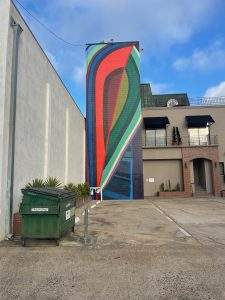

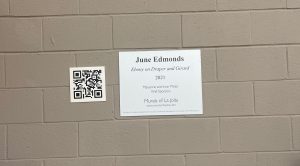
Lauren Halsey
From what I have seen of Halsey’s work, the standout features that stuck with me/ were reiterated by multiple biographical sources were were:
technicolor, funk, free-flowing, visionary, found materials, afrofuturism, sense stimulating, neighborhood archive, emancipatory narrative, community engagement, embodied activism
Resources to learn more about Halsey’ work:
HypeArt: Lauren Halsey Presents Her First Solo Exhibition in NYC
Umar Rashid
From what I have seen of Rashid’s work, the standout features that stuck with me / were reiterated by multiple biographical sources were were:
storytelling, illustrative, fantastical, painting, alternative narrative, intricate detail, iconographic, cultural exploration, revisionist, challenged historiographies, embodied activism
Resources to learn more about Rashid’s work:
Tiwani Contemporary: Umar Rashid
Zeus was a sexual predator (his work on Greek mythology is so so cool!)
VI. Conclusion & Imaginative Future Reality
Guiding Question(s): Is it too idealistic to hope that a simple solution could really just be museums holding themselves accountable for providing access to information and elevating the voices of artists? Can a gallery that supports artists financially and through exposure be an adequate alternative to museums like the Getty Villa who we cannot guarantee will ever hold themselves accountable? What if the Getty Villa had used this exhibit as an opportunity to educate about the project efforts of Transformative Arts, or had made a statement addressing the mistakes it has made concerning exclusivity of art in the past? Would these actions do political work?
Inspiration :
In brainstorming what a productive art world might look like — one that prioritizes community relationships and equitable access to art, I find that a role model is right in front of us. The people working at Transformative Arts have rooted their aims towards addressing exactly what we find to be lackluster at the Getty. Widespread support of organizations like this one and conscious effort to raise awareness events like those they host (which support artists in a multitude of ways) is a potential future reality that is much more real than imaginative. It is also inherently political to stand with these folks behind the scenes of Adornment | Artifact and Transformative Arts. They actively refuse the objective and exclusionary nature of power knowledge that underscores much of modern museum work. Their existence is a manifesto in itself, and an inspiration for how we can turn theory into praxis.
Below I have included a few more sources which I found worth elevating, since they share similar goals of transforming the creation and sharing of art into an accessible, sustainable, and community supporting act:
Image from: Why Cheap Art Manifesto
A Growing List of 90+ Black-Owned Galleries and Museums to Support Across the Globe
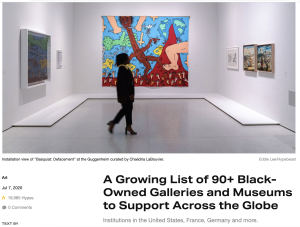
VII. Works Cited
“Artist’s Questionnaire: Lauren Halsey Sees the Future .” The New York Times Style Magazine. The New York Times Company, June 12, 2022. https://www.nytimes.com/2022/06/08/t-magazine/lauren-halsey.html.
“Current Exhibitions and Installations.” The Getty. J. Paul Getty Trust, https://www.getty.edu/visit/exhibitions/.
“June Edmonds.” Luis De Jesus Los Angeles, 2021. https://www.luisdejesus.com/artists/june-edmonds.
“June Edmonds.” Murals of La Jolla, 2021. https://www.muralsoflajolla.com/june-edmonds.
“June Edmonds | 2022 Gallery.” Fellowship for Visual Artists. California Community Foundation, 2022. https://www.calfund.org/nonprofits/featured-funds/fva/2022-gallery/june-edmonds/.
“Melvin Edwards.” Alexander Gray Associates. https://www.alexandergray.com/artists/melvin-edwards.
Nash, Jennifer C. “The Afterlives of Malaysia Goodson, or Black Mothering in Crisis.” Essay. In Birthing Black Mothers, 1–29. Durham: Duke University Press, 2021.
Pogrebin, Robin. “Lauren Halsey Brings Her Vision of South Central Los Angeles to New York.” The New York Times. The New York Times, May 6, 2022. https://www.nytimes.com/2022/05/06/arts/design/lauren-halsey-kordansky.html.
“Story.” Adornment | Artifact. Transformative Arts, 2022. https://www.adornmentartifact.org/.
“Studio Visit and Interview with Los Angeles Artist Umar Rashid.” Tappan. https://www.tappancollective.com/collections/studio-visit-umar-rashid.

